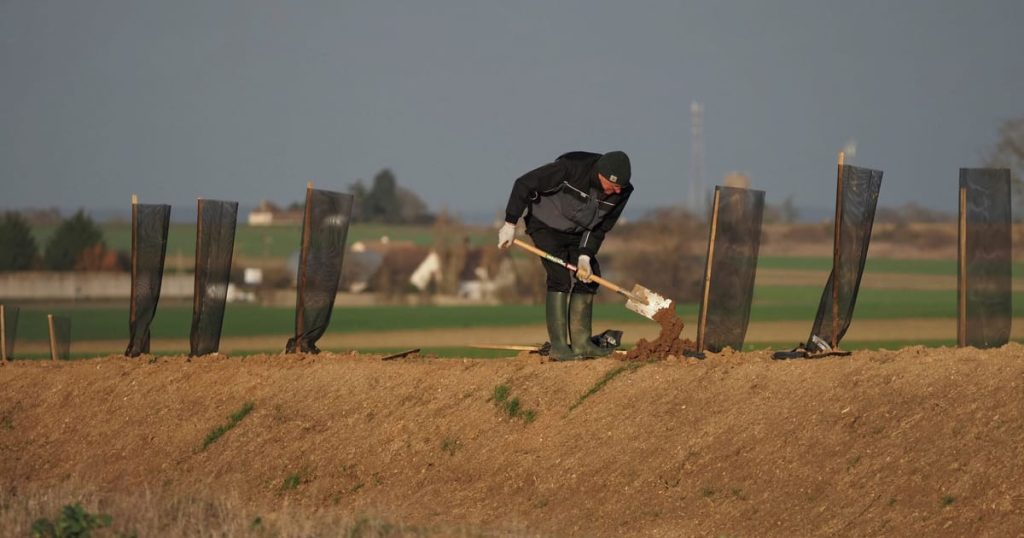Press play to listen to this article
Voiced by artificial intelligence.
Ist der Winter warm, wird der Bauer arm.
If the winter is warm, the farmer will be poor … so goes an old German proverb. Record-warm temperatures across Europe so far this month are helping stave off an energy crunch. But they bode ill for farmers and food prices.
With highs of nearly 20 degrees Celsius in parts of Poland and more than 25 degrees in Spain, seven European countries recorded their highest ever January temperature on New Year’s Day.
As well as alarming climate scientists, this has farmers in many parts of Europe worried. Without snow, the countryside suffers, as Italy’s largest farmers’ association, Coldiretti, has warned.
The mild temperatures have eased energy prices, which is good news for consumers who have been hit by soaring costs since Russia’s invasion of Ukraine, and the EU sanctions in response, which have wreaked havoc with the region’s energy market.
But a warm winter risks curbing crop yields at a time when farmers are already struggling with fertilizer shortages — another fallout from the war — and have not yet recovered from last summer’s drought. This puts pressure on the region’s rising food prices, which have stayed at record highs even as headline inflation has eased.
When temperatures rise too high, food prices follow, according to recent research by Paul Griffin, a professor at the UC Davis Graduate School of Management at the University of California who has investigated the economic and financial impact of extreme weather.
Fake spring
In the German state of Saxony-Anhalt, where Carl-Philipp Bartmer farms, the temperature went from minus 20 degrees Celsius to plus 17 degrees within the space of two weeks in December.
“I have never experienced anything like this before,” said the 33-year-old. “It’s completely crazy.”
Chief among Bartmer’s fears is that the volatility in temperatures will trick his crops of winter wheat and barley into germinating early.
These newly bloomed or “winter-proud” crops, as they are called, are more vulnerable to damage from frost — which does not matter if the mild temperatures continue. In fact, early growth can help farmers get a head start.
“But the problem is, winter is not over,” said Bartmer.
Next week, in the northwest of Europe, temperatures are due to drop below seasonal norms, according to forecasts.
The cold weather will soon hit eastern Germany again too, said Bartmer. When it does, he fears he could lose up to 70 percent of the winter barley and wheat crops sown on his 3,000 hectares of land.
“As a farmer you can’t take any measures to reduce the harm, you just have to hope the plants are strong enough,” he said.
Fruit crops, like apples, pears, plums, apricots, cherries and grapes, are also especially vulnerable to frost damage, according to Hans-Martin Füssel, a climate change vulnerability and adaptation expert at the European Environment Agency.
While the warm spell has farmers dreading the next bout of frost, a complete lack of snow can also cause problems, according to Füssel.
Warmer and more unpredictable weather is bringing new pests and more cycles of the same pests, said Luca Gaddoni of Coldiretti. This decreases yields and adds to farmers’ costs, he added.
No snow, no water
The biggest problem, though, according to experts, is that swathes of European farmland rely on water sources filled by snowmelt.
Snow is very good for irrigating soil because it covers the ground and melts little by little, so water is slowly absorbed over a long period, said Gaddoni. Heavy rain, by contrast, often ends up running off the surface — especially when it falls on dry earth which is less able to absorb water.
Lack of snow last winter caused Italy’s river Po, the country’s largest which runs through Italy’s agricultural heartland, to run dry.
The sizzling summer that followed compounded the problem, as the Adriatic Sea flowed back into the Po’s lower reaches, filling irrigation channels with salty water that harms crops and soils.
Across Europe, 2022 was the second hottest year on record. In many places it was also the driest. Italy had 30 percent less rain and snowfall than the historical average since 1991, Coldiretti estimates.
Now, with the country’s fields left arid from Europe’s summer drought and the water levels of great lakes like Garda and Como more than halved, Italian agriculture needs snow, said Paolo Di Stefano, head of Coldiretti’s Brussels office. But this winter’s warm temperatures risk a repeat of the year before.
This is exactly what Alessandro Calcagno, a rice farmer from Northern Italy’s Po Valley, has been hoping to avoid. In 2022 his yields dropped by five percent, he said.
Rain over the last few months of the year has offered some hope. But the high winter temperatures could deliver a setback as the absence of snow risks curbing water supplies for the coming season, he explained.
The combination of falling yields and rising costs on farms spells higher prices for consumers.
“And if food prices are raised, that’s very likely to cause inflation,” said Griffin, whose research charts how, when temperatures in Europe go above a certain point, businesses in general suffer as productivity and sales fall.
Further pressure on food prices comes from the uncertainty created by climate change, as Europe not only gets warmer, but its weather patterns also become more unpredictable, said Griffin. Faced with this, farmers and other firms in the food supply chain seek to build cash reserves to hedge against the increased risk.
The unpredictability also leaves many farmers, used to planning their year by the seasons, without a road map.
“We’ve been discussing [the warm weather] with all the other local farmers and nobody has a clear answer,” said Bartmer, the German farmer. “No one knows what it means or what can happen.”

